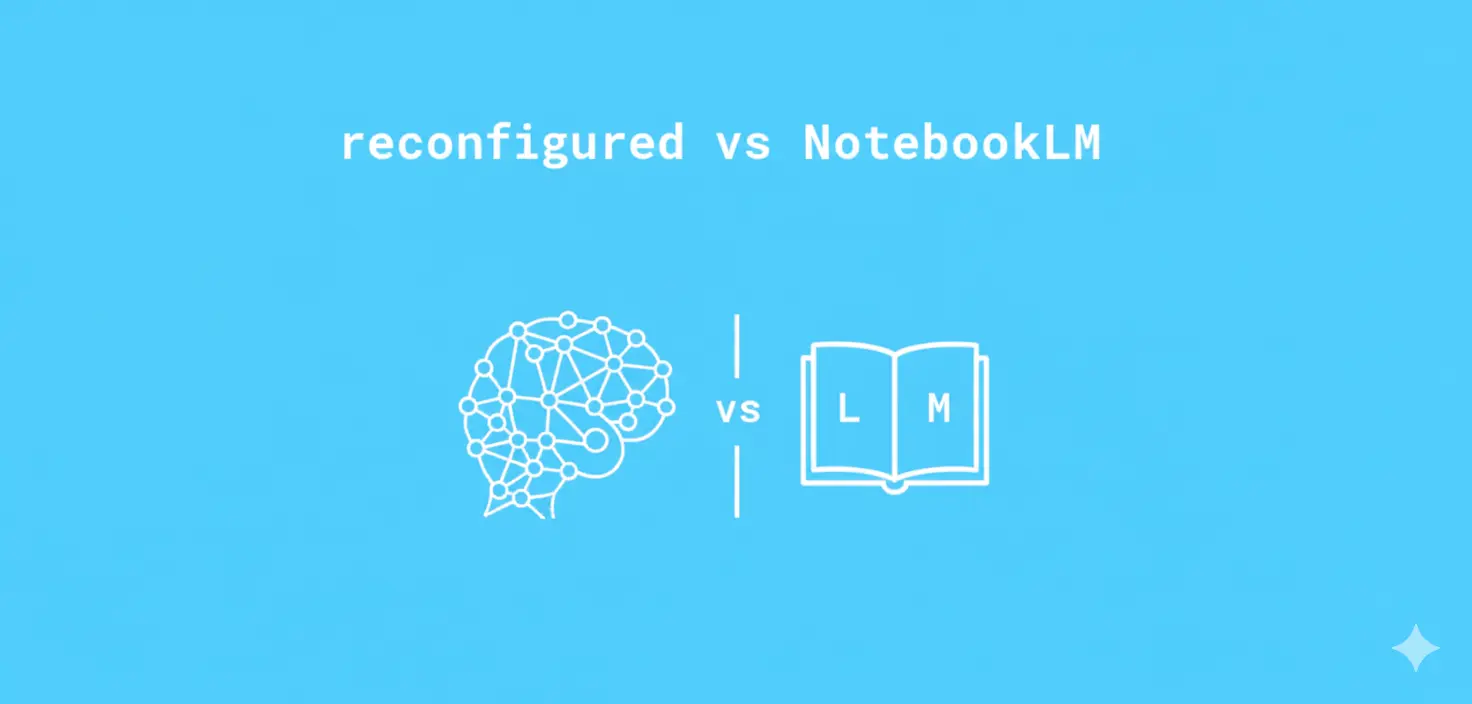
reconfigured vs NotebookLM: A Better Research Workflow
Better than NotebookLM for Research
If you’ve tried Google’s NotebookLM, you know the pitch: upload sources (PDFs, sites, Google Docs/Slides, YouTube, audio), then get grounded summaries, citations, and even AI-generated Audio and Video Overviews. It’s a big step forward for consumer research tooling. But if your work depends on capturing scattered thinking fast, organizing evolving knowledge, and shipping credible outputs with teammates, you’ll hit limits. That’s why we built reconfigured.
TL;DR — NotebookLM is optimized for reading collections of documents. reconfigured is optimized for doing research as you work—capturing, connecting, and iterating until the insight is solid enough to ship.
Quick Try: reconfigured
Ready to see how this feels in practice? 👉 Try reconfigured — capture with a hotkey, let AI organize in the background, and find what you were thinking yesterday in seconds.
What NotebookLM Is Great At
- Source-grounded Q&A and summarization. NotebookLM analyzes the sources you add and cites back to them.
- Rich AI overviews. Audio Overviews and Video Overviews provide narrated briefings from your materials, now rolling out globally with multilingual support.
- Broad input types. Add Google Docs/Slides, PDFs/Markdown/Text, websites, YouTube, audio, and pasted text (with generous per-source limits).
Verdict: For reading a bounded corpus and getting a guided tour, NotebookLM is excellent.
Where NotebookLM Falls Short for Day-to-Day Research
- Manual discovery burden. You still do most of the source-finding before NotebookLM can shine. Great for class packets; less great for constant, wide-angle canvassing.
- Static, notebook-bound context. Each notebook is a snapshot; real research is an ongoing stream of meetings, half-ideas, and evolving threads.
- Outputs need editorial lift. Even Google notes that AI overviews may contain inaccuracies—sensible to verify, but time-consuming.
Why reconfigured Fits Working Researchers
Most tools start from documents. reconfigured starts from thinking—the messy stream of notes, snippets, and context you create while you work.
- Capture first, organize later (without losing flow). One hotkey to jot anything; AI organizes in the background so raw notes become searchable context.
- Search that understands your work. Jump from a quick capture to relevant prior notes and related concepts; see what you were thinking yesterday and what you’re investigating today.
- From personal brain to team memory. Evolving shared knowledge so patterns become visible across projects and time.
Head-to-Head: The Research Workflow
1) Capture & Ingestion
- NotebookLM: Strong once sources are added; less help before that step.
- reconfigured: Instant capture anywhere; AI tagging/organization runs behind the scenes.
2) Exploration & Context-Building
- NotebookLM: Chat over a bounded, static set of sources—great for scoped literature.
- reconfigured: Treats your entire knowledge stream as living context that compounds.
3) Synthesis & Briefing
- NotebookLM: Video Overviews now support ~80 languages; Audio Overviews have been upgraded as well. Great for onboarding to a packet of materials.
- reconfigured: Turns your own notes into reusable, structured outputs you can iterate on.
When to Choose Which
Choose NotebookLM when you have:
- A well-bounded corpus (e.g., a fixed policy packet or class readings).
- A need for quick, narrated overviews to bring newcomers up to speed.
Choose reconfigured when you need to:
- Capture ideas the moment they occur and not lose them in the chaos.
- Build an evolving body of knowledge across projects/people with flexible tags over rigid folders.
- Turn messy notes into credible, repeatable outputs—again and again.
Bottom Line
NotebookLM is an excellent AI reader of what you load into it. reconfigured is an AI notepad for people who think for work, so your fleeting ideas and research stubs don’t just pile up—they compound.
👉 Try reconfigured now — capture instantly, organize automatically, and find faster.